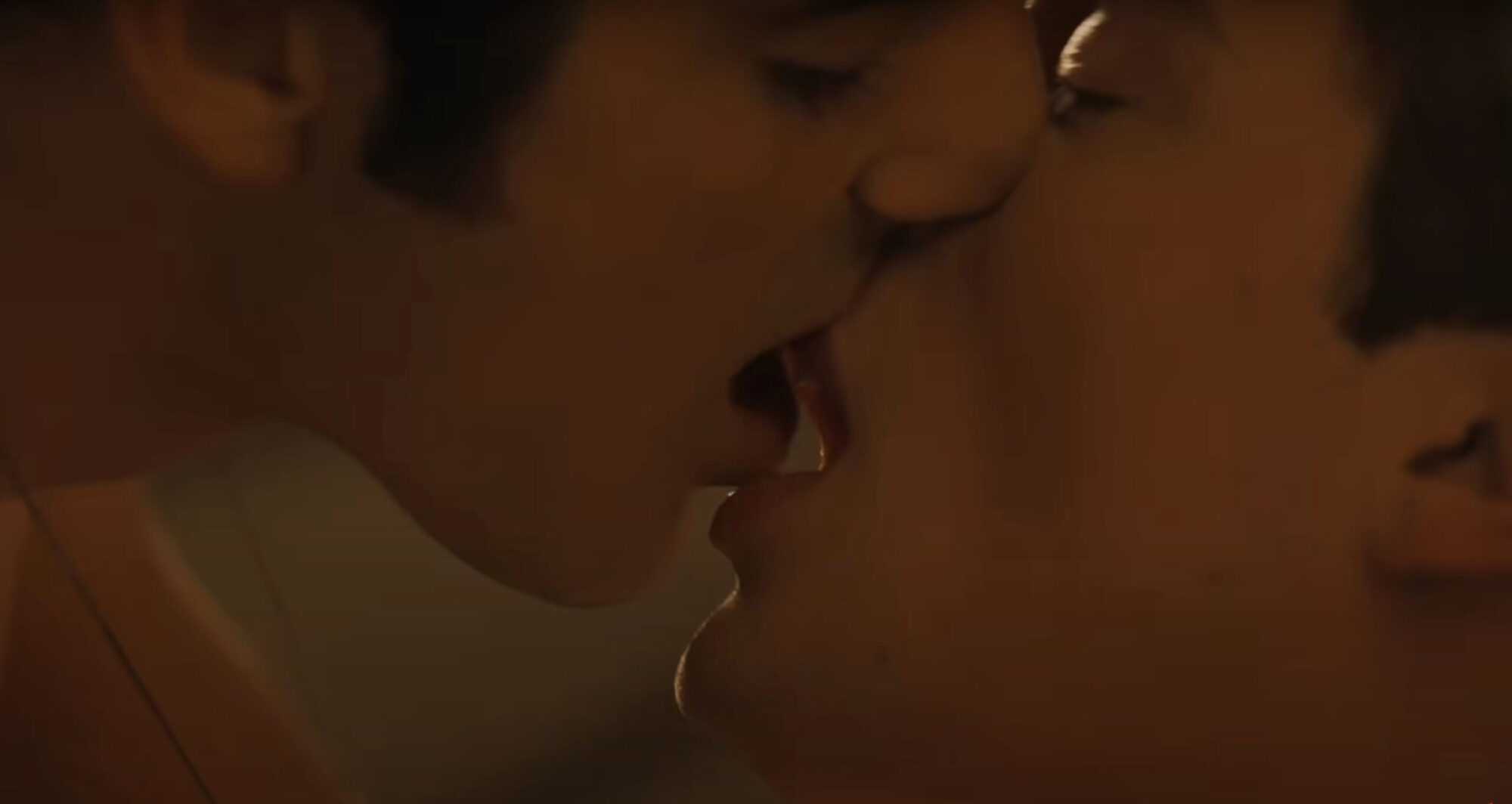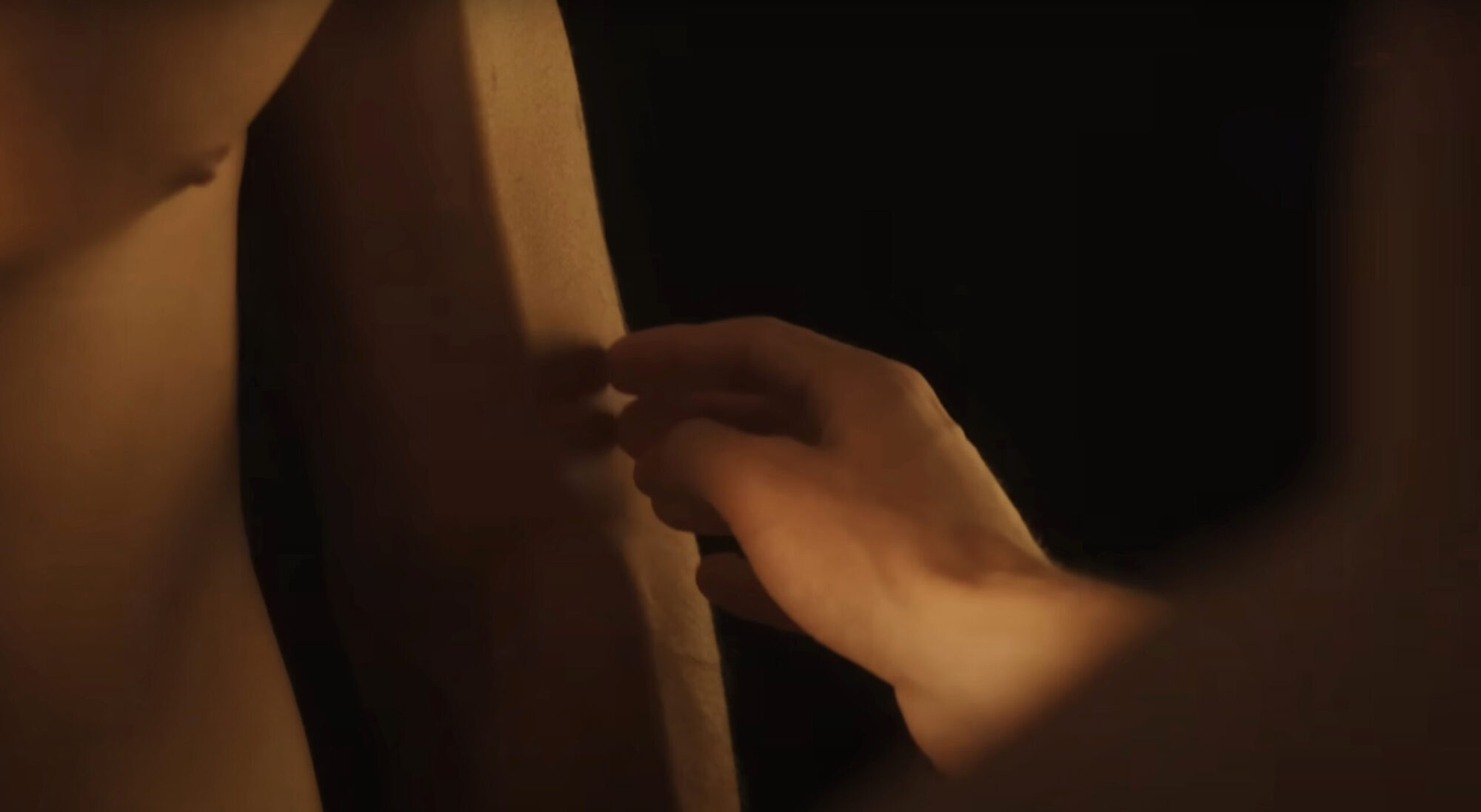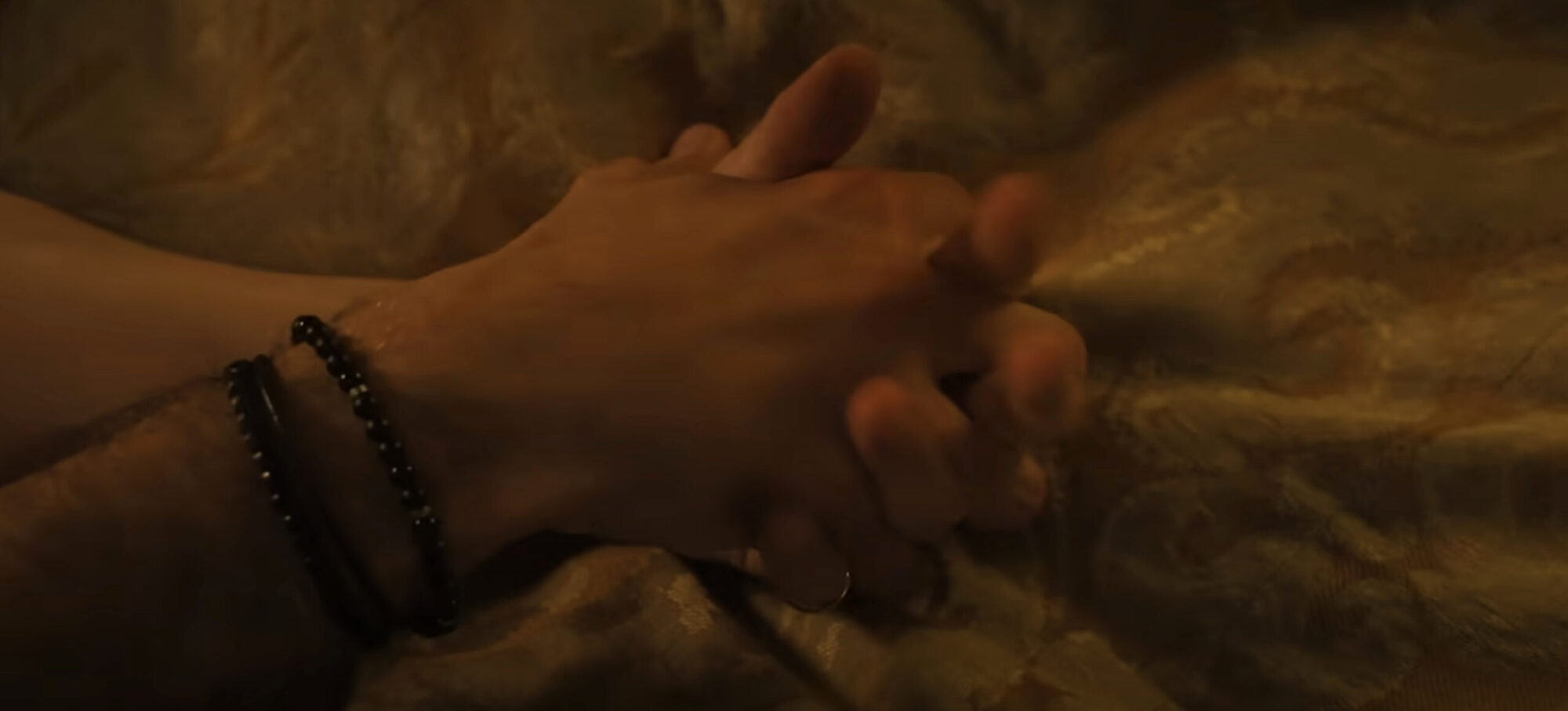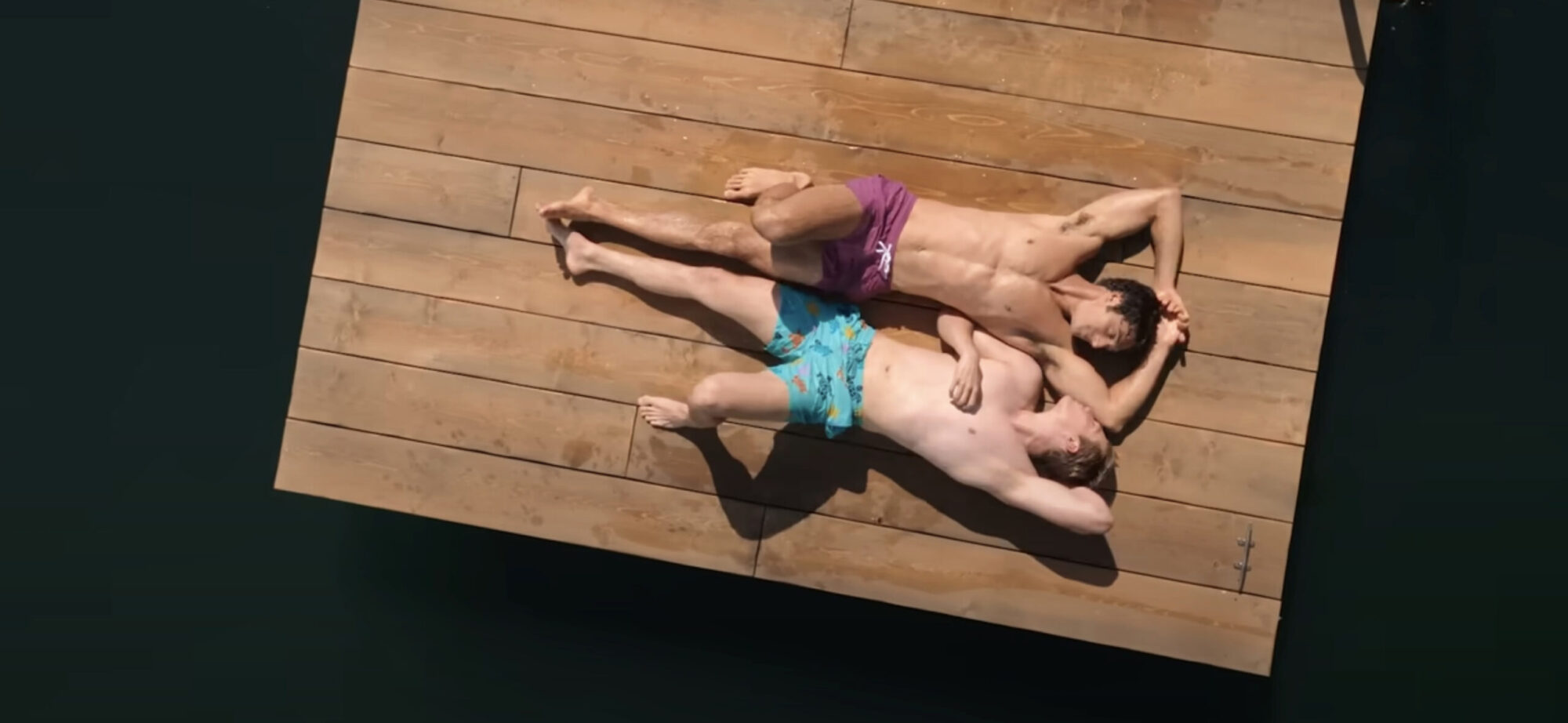I Like It Hot: Red, White & Royal Blue

Matthew Lopez, Red, White and Royal Blue, 2023 [courtesy of YouTube]
Share:
Please forgive the obvious circularity of this statement when I say that, despite my perception of the film’s marketing as a run-of-the-mill rom-com, Red, White & Royal Blue wasn’t made for straight women. My friend Kevin, a gay cis Black man, told me, “Yeah, no, that’s for you, babe.” I then felt guilty for loving it. Was I part of the problem?
Boy, do I love this movie.
I mean really love it. I love it so much. Goddamn, I love this movie! “But daddy,” I said to Kevin, “dude’s thigh was in the frame.”
Matthew Lopez, Red, White and Royal Blue, 2023 [courtesy of YouTube]
The scene:
In the “missionary” position, on top, Taylor Zakhar Perez, as Alex, is mirroring Henry’s breath with his own, the rhythm of the men’s lovemaking keeping time with their breathwork. Henry’s hand moves to the small of Alex’s back. Henry presses down on Alex’s back, essentially pulling Alex deeper inside him. Henry and Alex stare into each other’s eyes. We see Henry—a visibly captivated Nicholas Galitzine—with his legs spread, wide enough that his left thigh is in the frame, knee bent. Wide enough to convey to the audience that penetration is certainly happening.
“That wasn’t believable. It was too romanticized. Henry didn’t even grimace. Not one time. He not taking all that dick like that.” Kevin is a lithe, long-limbed, slender man. I argued, well, the filmmakers aren’t going to show that. Can’t show that. What would that do? Our conversation was a revealing one. I learned a lot about audience expectations and my own proclivities. I gained a more nuanced understanding of the subtle differences and entanglements between pandering, catering to an audience, and doing the right thing—how indistinguishable one gesture can be from another. I also learned that most male/male romance novels (not to be conflated with “gay romance”1 are written by straight cis white women.
“Huh?” I said. We felt nourished recalling Rainer Werner Fassbinder’s superb 1982 adaptation of Jean Genet’s Querelle of Brest, a poetic and dizzying feat of strength. Are American audiences, regardless of orientation, ready for that one yet? The scene with Alex and Henry shows us what’s at stake here—that in their shared exhalation, in the carnal, something true and profound could be expressed.
At the time of this article’s writing, I’d already seen the film nine times in six weeks. The first time, I had a mound of laundry to fold and thought to myself, let me put on something light and dumb that I don’t have to pay that much attention to—I could focus on the domestic task at hand and be entertained while doing it. By the time Henry tells Alex, “Christ, you’re as thick as it gets,” before kissing him, or maybe those rapid close-up shots of Henry’s ass bouncing on that saddle during a polo match, I’d stopped folding laundry.
Matthew Lopez, Red, White and Royal Blue, 2023 [courtesy of YouTube]
I rewound many scenes, many times. This wasn’t Brokeback Mountain, Call Me by Your Name, And Then We Danced, The Handmaiden, Moonlight—movies I’d cried my eyes out to, cheering for the love and the longing—nor was it Gregg Araki. But Red, White & Royal Blue felt indebted to those films, to Araki, to Todd Haynes, to Isaac Julien, to Tom Kalin, to all the 90s’ indie “gay movies.” Together, they all forged paths to these characters’ declaring their own liberation.
Henry: “Hurry, please.”
Alex: “I’ll break the sound barrier for you.”
“Who wrote this script?” I said out loud to the laptop. I was laughing my head off at how cheesy and earnest and sentimental the dialogue was—the fluff and politics of the story’s premise. Then, finding brilliant just how cheesy and earnest and sentimental this dialogue was. The film doesn’t squander its opportunities. The director, Matthew López, manages to expose the film’s own hypocrisy while gleefully reveling in it. Is hypocrisy too strong a word? The film embraces its own middle-of-the-road-ness, its impulse to exploit the very thing it’s celebrating, but still manages to not give it all away.
Wait, I’m getting it wrong. Planting itself middle-of-the-road is the film’s Trojan horse. The put-on or dress-up of all the trappings of a rom-com, boy hates boy, boy loves boy, hilarity and cake ensue, feels like a headline that I read everywhere. Yes, it is a rom-com. But in this instance, I don’t have to look past the genre’s usual formulaic critique and ultimate re-inscribing of normative gender roles—a genre simultaneously shunning, and cashing in on, that performativity. Pretty Woman is not a Marxist coming-of-age tale about sex work—a lie I told myself for years. It’s just another Pygmalion story that goes out of its way to go ga-ga over white heteronormative male behavior. I watch it on Valentine’s Day each year.
In Red, White and Royal Blue, a character shouts out Wong Kar-wai’s lush In the Mood for Love for being swoony—“the swooniest,” as Henry calls it. This gesture tells me that López’s rom-com could also be a dense, sensitively told, gorgeous movie. It is, really.
I hope there will be a sequel. And please, will there be more fucking? A serialization from Casey McQuiston? I sound desperate, I know. But for those of you who’ve streamed the film, weren’t you relieved when there was no cutaway shot or fade to black after some tepid, stagey groping? Two bottles of lube are seen on the bedside table in this movie. Red, White & Royal Blue is a kajillion times more fearless than, say, Saltburn. And not once did it wrestle me to the ground amid menstrual ketchup, the worms of a freshly tilled grave, or slurping, to prove it.
Matthew Lopez, Red, White and Royal Blue, 2023 [courtesy of YouTube]
Sherae Rimpsey is an artist and writer. Rimpsey is the Mildred Thompson Art Writing and Editorial Fellow.
The Mildred Thompson Arts Writing and Editorial Fellowship is a collaboration between Art Papers and Newcomb Art Museum at Tulane University. Funding for the two-year editorial position was provided to Newcomb Art Museum by the Andrew W. Mellon Foundation for an emerging Black arts writer/editor to gain hands-on experience as part of Art Papers’ editorial team. The fellowship also honors and builds upon the legacy of Mildred Thompson, associate editor of ART PAPERS from 1989 to 1997.
Conceptualized as part of Art Papers’ Diversity, Equity, Inclusion, and Accessibility efforts, the fellowship received seed funding from AEC Trust and The Homestead Foundation to pilot the program in 2022.
References
| ↑1 | A genre more typically written by and for gay men. |
|---|


